
West Kalimantan is a province of Indonesia. It is one of five Indonesian provinces comprising Kalimantan, the Indonesian part of the island of Borneo. Its capital and largest city is Pontianak. It is bordered by East Kalimantan and Central Kalimantan to the east, the Malaysian state of Sarawak to the north, and the Bangka Belitung Islands to the west and the Java Sea to the south. The province has an area of 147,037 km2, and had a population of 4,395,983 at the 2010 Census and 5,414,390 at the 2020 Census; the official estimate as at mid 2023 was 5,623,328, and was projected to rise to 5,695,500 at mid 2024. Ethnic groups include the Dayak, Malay, Chinese, Javanese, Bugis, and Madurese. The borders of West Kalimantan roughly trace the mountain ranges surrounding the vast watershed of the Kapuas River, which drains most of the province. The province shares land borders with Central Kalimantan to the southeast, East Kalimantan to the east, and the Malaysian territory of Sarawak to the north.

South Kalimantan is a province of Indonesia. It is the smallest province in Kalimantan, the Indonesian territory of the island of Borneo. The provincial capital was Banjarmasin until 15 February 2022 when it was legally moved 35 kms southeast to Banjarbaru. The population of South Kalimantan was recorded at just over 3.625 million people at the 2010 Census, and at 4.07 million at the 2020 Census. The official estimate as at mid 2023 was 4,221,929. One of the five Indonesian provinces in Kalimantan, it is bordered by the Makassar Strait in the east, Central Kalimantan in the west and north, the Java Sea in the south, and East Kalimantan in the northeast. The province also includes the island of Pulau Laut, located off the eastern coast of Kalimantan, as well as other smaller offshore islands. The province is divided into 11 regencies and 2 cities. South Kalimantan is the traditional homeland of the Banjar people, although some parts of East Kalimantan and Central Kalimantan are also included in this criterion. Nevertheless, South Kalimantan, especially the former capital city Banjarmasin has always been the cultural capital of Banjarese culture. Many Banjarese have migrated to other parts of Indonesia, as well as neighbouring countries such as Singapore and Malaysia. In addition, other ethnic groups also inhabit the province, such as several groups of the Dayaks, who mostly live in the interior part of the province, as well as the Javanese, who mostly migrated from Java due to the Transmigration program which dated from the Dutch colonial era. It is one of the provinces in Indonesia that has a larger population than Mongolia.
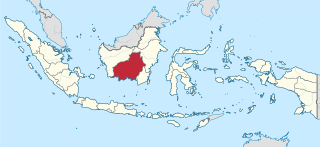
Central Kalimantan is a province of Indonesia. It is one of five provinces in Kalimantan, the Indonesian part of Borneo. It is bordered by West Kalimantan to the west, South Kalimantan and East Kalimantan to the east, Java Sea to the south and is separated narrowly from North Kalimantan and Malaysia by East Kalimantan's Mahakam Ulu Regency. Its provincial capital is Palangka Raya and in 2010 its population was over 2.2 million, while the 2020 Census showed a total of almost 2.67 million; the official estimate as at mid 2023 was 2,774,747, and was projected to rise to 2,809,700 at mid 2024.
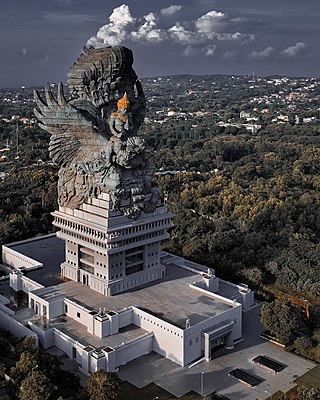
The culture of Indonesia has been shaped by the interplay of indigenous customs and diverse foreign influences. With over 1,300 distinct ethnic groups, including significant Austronesian and Melanesian cultures, contributing to its rich traditions, languages, and customs, Indonesia is a melting pot of diversity. Positioned along ancient trade routes between the Far East, South Asia, and the Middle East, the country has absorbed cultural practices influenced by Hinduism, Buddhism, Confucianism, Islam, and Christianity. These influences have created a complex cultural tapestry that often differs from the original indigenous cultures.

Kaharingan is an indigenous monotheistic folk religion of the Dayak people such as Katingan, Lawangan, Ma'anyan, Ngaju, Ot Danum people native to the Central Kalimantan and South Kalimantan region in Indonesia.

Madurese, Madurans, Madurites or Madurace are one of the Javan ethnic groups native to the Indonesian island of Madura in Java Sea, off the northeastern coast of Java. They speak their own native Madurese language, shared common history, traditions, and cultural identity. Nationwide, the Madurese are the third largest ethnic group in Indonesia, and one of the well-known Indonesian national dishes of Satay also ultimately attributed as the national culinary heritage of Madura-origin invented by the Madurese.
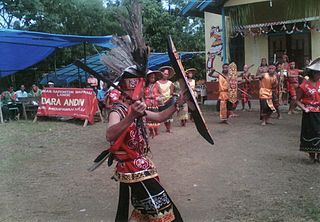
The Kendayan are an Indonesian ethnic group native to Kalimantan, Indonesia in Borneo. The population of the group is around 366,000.
Selakoa.k.a.Selakau, Salako or Silakau are the indigenous people native to the Selakau regions in Sambas Regency of West Kalimantan, Indonesia. Nowadays, the Selako diaspora can be found in the neighbouring Selakau regions as well; including the districts of Pemangkat, Paloh, Tebas, Teluk Keramat, Sejangkung, Sajingan Besar in Sambas Regency, the East Singkawang district in Singkawang, the districts of Tujuh Belas and Samalantan in Bengkayang Regency, and the Lundu district in Sarawak. Selako people are sometimes classified as part of larger Dayaks community, thus sometimes they are called as Selako Dayaks as well. Their native or indigenous language is the Selako language. Like any other indigenous Dayak groups, the Selako people embraced the Kaharingan religion, but many Selakos diaspora tend to have Christians and Roman Catholics faiths after the mass conversion by missionaries in the 19th century.

The Kahayan River, or Great Dayak River, is the second largest river after the Barito River in Central Kalimantan, a province of Indonesia in Kalimantan – the Indonesian part of the island of Borneo. With a total length of 658 km (409 mi) and with a drainage basin of 15,500 km2 (6,000 sq mi) in South Kalimantan, Indonesia. Mean annual discharge 1,178 m3/s (41,600 cu ft/s). The provincial capital Palangkaraya lies on the river. The main inhabitants are Dayaks, who practice slash-and-burn rice cultivation and pan for gold on the upper reaches. The lower Kayahan flows through a rich and unusual environment of peat swamp forests, which has been severely degraded by an unsuccessful program to convert a large part of the area into rice paddies, compounded by legal and illegal forestry.

The Borneo Orangutan Survival (BOS) Foundation is an Indonesian non-profit non-governmental organization founded by Dr. Willie Smits in 1991 and dedicated to the conservation of the endangered Bornean orangutan and its habitat through the involvement of local people. It is audited by an external auditor company and operates under the formal agreement with the Indonesian Ministry of Forestry to conserve and rehabilitate orangutans. The BOS Foundation manages orangutan rescue, rehabilitation and re-introduction programmes in East and Central Kalimantan. With more than 400 orangutans in its care and employing more than 440 people at a 10 sites BOS Foundation is the biggest non-human primate conservation non-governmental organization worldwide. Nyaru Menteng and Samboja Lestari are the BOS Foundation sites that have received most extensive media coverage. Nyaru Menteng, founded by Lone Drøscher Nielsen, has been the subject of a number of TV series, including Orangutan Diary, Orangutan Island and the series Orangutan Jungle School, airing since 2018.

Rumah adat are traditional houses built in any of the vernacular architecture styles of Indonesia, collectively belonging to the Austronesian architecture. The traditional houses and settlements of the several hundreds ethnic groups of Indonesia are extremely varied and all have their own specific history. It is the Indonesian variants of the whole Austronesian architecture found all over places where Austronesian people inhabited from the Pacific to Madagascar each having their own history, culture and style.
Wehea Forest is a 38,000 ha rainforest located in East Kutai Regency, East Kalimantan, Borneo. Wehea was declared a protected forest in 2004 by the Wehea Dayak. This project received the Kalpataru Award in 2009, Indonesia's highest environmental honor. It currently is a co-managed forest between the local Wehea Dayak people from the village of Nehas Liah Bing and Wehea Management Body. The Kepala Adat of Nehas Liah Bing is Ledjie Taq.
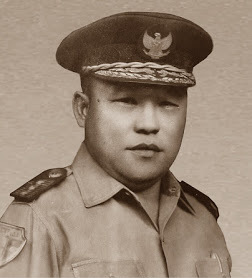
Johanes Chrisostomus Oevaang Oeray was an Indonesian politician. He was the Governor of West Kalimantan from 1960 to 1966; he was the first ethnic Dayak to hold the position.
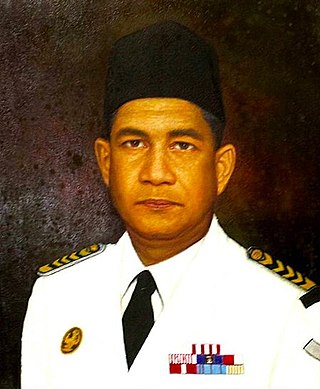
Anakletus Tjilik Riwut was an Indonesian military officer and journalist who served as the governor of Central Kalimantan from 1959 to 1967. He participated in the Indonesian National Revolution, becoming one of the leaders of the Kalimantan Physical Revolution in Dutch Borneo. In 1988, the government of Indonesia declared him a national hero.
Mina Susana Setra is an indigenous, environmental and land rights activist from Borneo. She serves as an activist for the Indigenous People's Alliance of the Archipelago and was instrumental in securing a ruling from the Constitutional Court recognizing customary land rights of indigenous people.
Mandau Talawang Pancasila is a paramilitary organization, based mostly within the Indonesian provinces of Central Kalimantan and West Kalimantan.
National Dayak Customary Council is an official customary council of the Dayak people in Indonesia that acts as the highest authority over other cultural or traditional councils of the Dayak people. It has branches from the provincial level to the village level in the entire Kalimantan and is funded by the Indonesian government. It was established on 5 September 2006 after the 2nd National Indonesian Dayak Conference in Pontianak regarding matters of funding the organization and its structure, and has been incorporated into laws by various local governments in Kalimantan. The president of the council is elected by representatives of regional branches for a five year term. The current president of the council from 2021 to 2026 is Marthin Billa, who was previously regent of Malinau Regency and chief of the North Kalimantan provincial Dayak Council.
Batamad, abbreviation from Barisan Pertahanan Masyarakat Adat Dayak, is an official paramilitary under National Dayak Customary Council in Indonesia. It was established in February 2012 with approval of Central Kalimantan provincial government based on Regional Law Number 16 of 2008. Initially, it was created as a response of rising religious extremism in Indonesia, including Central Kalimantan, and the paramilitary was tasked to supervise suspicious religious activities there, particularly those allegedly by Islamic extremism. Other than that, the organization is also tasked to enforce customary laws under Dayak culture, enforcing tribal land claims, as well as protecting rights of Dayak people. It is proposed in 2018 by Central Kalimantan province that the organization would also act as a security personnels during tribal courts. However, outside of its given legal authorities, the organization also participate in enforcing road traffic with Indonesian National Police. The organization has been descibred by local media as an "official tribal police".

Nusantara Capital City Authority is a cabinet level-agency formed by the Indonesian government, working directly under the President of Indonesia. The agency will become a special agency tasked with managing and governing the city of Nusantara, future capital of Indonesia located on Kalimantan.

Nusantara, officially the Capital City of Nusantara, is the future capital of Indonesia, located between Kutai Kartanegara Regency and Penajam North Paser Regency, East Kalimantan, on the island of Borneo. Nusantara is planned to be a special capital region at the provincial level, replacing Jakarta.














